24 May “I’m trying to build a digital model big enough & strong enough, (for when) print revenue is at zero.” — Mark Thompson, CEO, New York Times
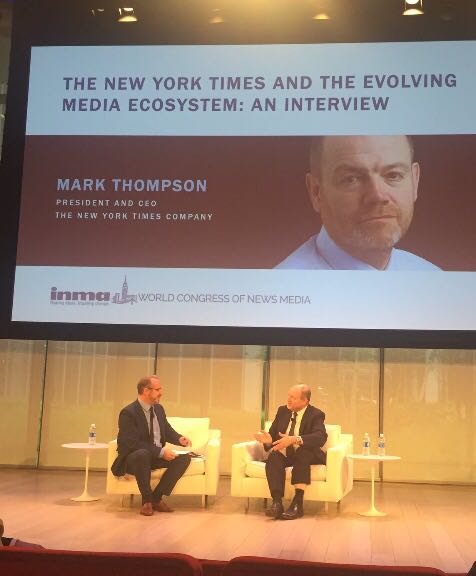
INNOVATION Media Consulting Partner Juan Señor interviewed Mark Thompson, president and CEO of The New York Times Company on Tuesday at the INMA World Congress in New York. Over the course of an hour, they discussed digital subscriptions, innovation, credibility and fake news, managing the print transition, and how to navigate all of those changes.
Here are some of the proceedings according to those in the audience on Twitter:
Packed house at INMA World Congress on final afternoon for interview with New York Times CEO Mark Thompson #INMA17 pic.twitter.com/Z1GEBwrIRP
— Earl J. Wilkinson (@earljwilkinson) May 23, 2017
Great conversation with NYT CEO #INMA17 pic.twitter.com/p3j502iF3C
— Pam Siddall (@PamSiddall) May 23, 2017
An hour with @nytimes President & CEO Mark Thompson. #INMA17 #newsgeek pic.twitter.com/fN2Xd9LdSr
— Dawn McMullan (@dawnmcmullan) May 23, 2017
Juan Señor began the interview by asking Thompson about a new subscription model. The Times’ goal is to reach 10 million subscribers.
“I think the idea that we should aspire to have 10 million [subscribers] or more is not in any way crazy,” Thompson said. “I think that’s the kind of scale and ambition we should have.”
“Broadly, we saw that the proportion of new subscribers coming from the rest of the world was staying steady with previous quarters,” he noted. “So, you have an intensely American story, yet we’re actually getting 14% of new subscribers from outside the U.S.”
Mark Thompson CEO @nytimes We're a subscription-first organization. #editorialanalytics #INMA17
— Santiago Lyon (@slyon66) May 23, 2017
How has the NYT has managed its transition from digital ad revenue to reader revenue?
Mark Thompson CEO @nytimes I hope print lasts forever but I'm planning for a digital-only future. #editorialanalytics #INMA17
— Santiago Lyon (@slyon66) May 23, 2017
What content triggers a subscription?
What content triggers a subscription? -Señor? Response: "Propensity to read multiple kinds of quality content"- Thompson #inma17
— Terri-Karelle Reid (@TerriKarelle) May 23, 2017
Ziel @nytimes: 10 Mio. Digital Subscribers – das wäre ein Signal für die gesamte Branche, dass Journalismus was wert ist pic.twitter.com/Q0TBZual78
— Pit Gottschalk (@pitgottschalk) May 23, 2017
– I have not yet met a news publisher who is in risk of changing too fast, says NYT CEO Mark Thompson at #INMA17. pic.twitter.com/ZfGBW1hE5p
— Ulrik Haagerup (@UlrikHaagerup) May 23, 2017
Thompson CEO @nytimes There are many newspaper publishers at risk of failing because not changing fast enough #editorialanalytics #INMA17
— Santiago Lyon (@slyon66) May 23, 2017
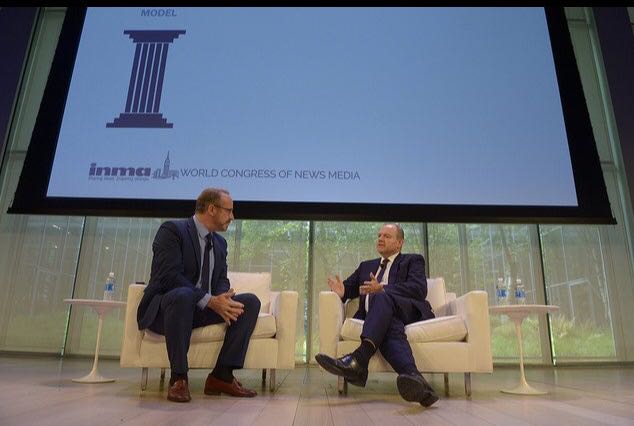
Explain the new strategy to transform the NYT from a “world class news brand” to a “world class consumer brand.” What does this mean precisely regarding audience research, analytics and the customer relationship?
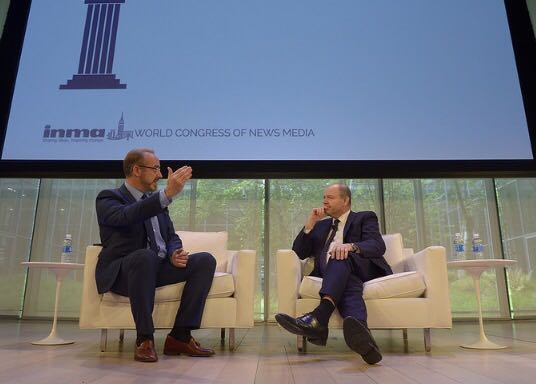
How will you transition from selling content to selling a membership in a community?
Events, e-commerce aren't going to save our biz. Journalism will do it with digital subs -Thompson @nytimes #INMA17
— Grzegorz Piechota (@g_piechota) May 23, 2017
Thompson: add-on business will not save the @nytimes; bulk of revenue must come from sales. #inma17 pic.twitter.com/8YOqNgiYiy
— INMA (@INMAorg) May 23, 2017
"Advertising and eCommerce revenues won't save media publishers. Paid content and subscription will." Mark Thompson, CEO @nytimes #Inma17
— Bartek Pucek (@barticz) May 23, 2017
The Live events business are add ons to the @nytimes strategy, but nothing takes away from the importance of the journalism. #inma17
— ITMediaSolutions (@IrishTimesSales) May 23, 2017
Events are cash-flow positive and good for the brand. But it would not save the news business, says Mark Thompson, CEO @nytimes at #INMA17
— Gerold Riedmann (@gerold_rie) May 23, 2017
Candid advice as to dos and don’ts for publishers contemplating a similar journey from over-dependence on digital ad revenue to reader revenue?
Mark Thompson @nytimes: Print is now 1/3rd ad revenue and 2/3rd subscription revenue. I expect something similar on the digital side #inma17
— Gerold Riedmann (@gerold_rie) May 23, 2017
Legacy media struggles: offers subscription, depens on print, courts online advertisement… Interesting interview to @nytimes CEO #INMA17 pic.twitter.com/Y3ISutg6iY
— David Alandete (@alandete) May 23, 2017
"I don't want to look back & say we didn't experiment enough. This is a race against downward lines on PPT" Mark Thompsen, @nytimes #INMA17 pic.twitter.com/kXf69inKZ3
— Corey Ford (@coreyford) May 23, 2017
Juan Señor then began asking Thompson about the 2020 digital revenue target. How would he get to the stated $800 million target in digital revenue from half that in 2015, given that in 2016 it was slightly above $450m?
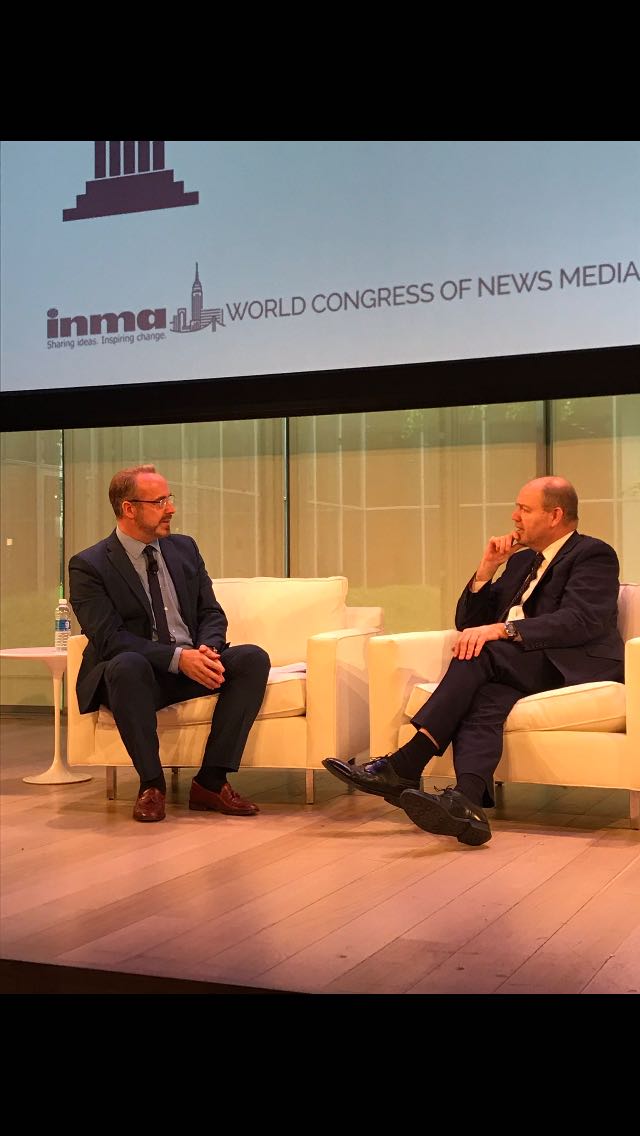
How do you use print as a ‘bridge to the future’ – and is it a stated intention to make print ‘disappear’ in due course?
"I'm trying to build a digital model, big enough & strong enough, (for when) print revenue is at zero." Mark Thompson, CEO @nytimes #INMA17 pic.twitter.com/rJbmRjljuZ
— Diane Hannay (@dianehannay) May 23, 2017
Is your vision to sell ‘things,’ experiences or ‘belonging’ in addition to content/journalism to get to the $800 million?
Mark Thompson, CEO @nytimes at #INMA17 – 'our business is journalistic storytelling, no one should beat us at that.'
— Katarzyna Buszkowska (@KBuszkowska) May 23, 2017
Mark Thompson, @nytimes CEO: We don't have any history in broadcast journalism, “so we can be a disruptor.” #inma17
— INMA (@INMAorg) May 23, 2017
How do you see digital advertising evolving? Is branded/native advertising delivering on the hype and expectations of two years ago? NYT Studio’s performance?
"We have more people in advertising creative team than in advertising sales teams" Mark Thompson, CEO @nytimes at #Inma17 pic.twitter.com/rpITlpah8d
— Bartek Pucek (@barticz) May 23, 2017
.@nytimes wants to be a destination. And: the blank spaces we sold in print don't exist on smartphones. Vid with CEO Mark Thompson. #INMA17 pic.twitter.com/BAwS70F95M
— Gerold Riedmann (@gerold_rie) May 23, 2017
Mark Thompson: What is the angle of attack? That's the y-o-y growth of digital revenue – not digital readership. #inma17
— Gerold Riedmann (@gerold_rie) May 23, 2017
Juan Señor then focused on visual journalism in his line of questioning. “You have made visual journalism one of the cornerstones of how the NYT newsroom will deliver the content expected in the digital age – what does this mean precisely?” he asked.
Juan Señor suggests "non-linear" as opposed to "visual journalism." i.e.Non- linear..breaking the text and creating more narratives #inma17
— Terri-Karelle Reid (@TerriKarelle) May 23, 2017
Mark Thompson, @nytimes CEO on new technology like #VR: “It’s been a way of funding experimentation, having crazy fun…" (1/) #inma17
— INMA (@INMAorg) May 23, 2017
@nytimes …finding great partners to go along the journey, and trying to redefine our brand around innovation." (2/2) #inma17
— INMA (@INMAorg) May 23, 2017
Mark Thompson CEO @nytimes VR and 360 have been cash positive to us since day one. #editorialanalytics #INMA17
— Santiago Lyon (@slyon66) May 23, 2017
From the plethora of multi-media formats you are exploring today – videos, photos, infographics, graphics, podcasts – is there something that stands out and triggers subscriptions?
Thompson: “You can’t fool yourself that something as big as the palm of your hand can be the same as a broadsheet newspaper." #inma17 pic.twitter.com/Ilmqf242d0
— INMA (@INMAorg) May 23, 2017
"Battles will be won or lost on smartphones" -Mark Thompson @nytimes #inma17
— Terri-Karelle Reid (@TerriKarelle) May 23, 2017
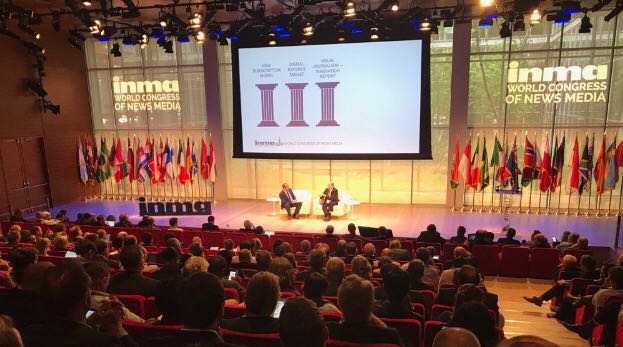
Where are we with the implementation of the Innovation report?
Is your newsroom still too paper-centric? Is that still the ‘king’ platform?
Thompson: “We want to see constant innovation in our print product.” #inma17
— INMA (@INMAorg) May 23, 2017
How do you transform a text-based newsroom into a visual newsroom?
Mark Thompson CEO @nytimes Change must come from within the newsroom. Let them tell you. #editorialanalytics #INMA17
— Santiago Lyon (@slyon66) May 23, 2017
@nytimes constantly challenge their print team to look at innovations across the brand. It is worth 62% of their ad revenue #INMA17
— ITMediaSolutions (@IrishTimesSales) May 23, 2017
"We don't want to be beaten in innovation on journalism storytelling." MarkThompson @nytimes #INMA17
— Eimear Moran (@emesmc) May 23, 2017
@nytimes doesn't want other entities beating them in their own journalistic space. They want to experiment, test and innovate #inma17
— Terri-Karelle Reid (@TerriKarelle) May 23, 2017
In his final 15 minutes with Thompson, Juan Señor focused on mobile. “It’s been said within the NYT, that mobile is the platform of the future present. What does that mean? Mobile=massive audiences on a massively reduced space to place advertising; how on earth do you make money on mobile?” he asked.
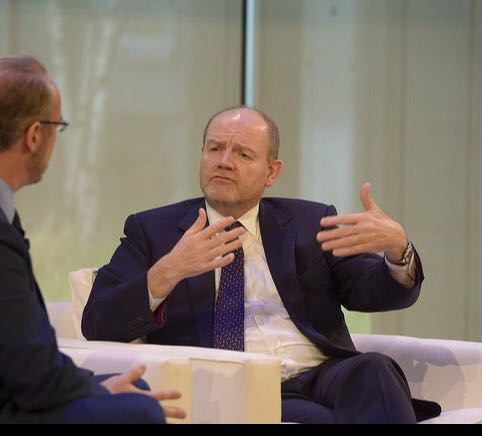
Tablet is nice platform but already mature. It is smartphone that we focus on- Thompson, CEO @nytimes #INMA17
— Grzegorz Piechota (@g_piechota) May 23, 2017
The battle will be won or lost on the smartphone – Thompson #inma17
— Pam Siddall (@PamSiddall) May 23, 2017
@nytimes don't talk about a mobile 1st strategy, for them it's a smartphone 1st strategy. This is where battles will be won & lost #inma17
— Eimear Moran (@emesmc) May 23, 2017
Thompson CEO @nytimes The battle will be won/lost on the smartphone. The tablet has matured, it is what it is. #editorialanalytics #INMA17
— Santiago Lyon (@slyon66) May 23, 2017
For a more detailed account of the interview, please visit the INMA World Congress blog entry here.


